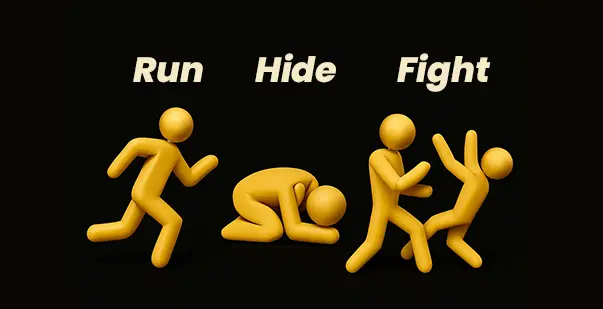If a gunman opened fire in a public setting, how would you respond? Although it's a frightening situation, being ready can save lives. The FBI reports that there were 48 active shooter incidents in the US in 2023 alone. These assaults may occur in shopping centers, workplaces, schools, or hospitals. They can occur quickly and frequently without warning, which is why knowing how to react is important.
Active shooter training for employees helps them stay calm, think clearly, and protect themselves and others. So, read on to learn who an active shooter is, who needs training, and how to be prepared. This knowledge could help you stay safe and even save lives.
What Is Active Shooter Training?
Active shooter training teaches people what to do if someone starts shooting in a public place like a school, office, or store. The goal is to help you stay safe and know how to act quickly in a scary situation.
During the training, you learn simple steps like:
Run if you can safely get away
Hide if you can’t run
Fight only as a last resort to protect yourself
Anyone attempting to use a gun to harm people in a public setting is known as an active shooter. They may choose to target particular individuals or random ones. That’s why it’s so important to know what to do right away. A safety program called "active shooter training" instructs participants on how to respond in the event of a live shooting.
The training focuses on three key actions: Run, Hide, Fight, run away if possible, hide if escape isn’t safe, and fight as a last resort. These steps are taught through drills, videos, and real-life simulations so that people can stay calm and respond quickly in a high-stress moment.
Who Needs Active Shooter Training?
Active shooter training isn’t just for security guards or law enforcement. It's for everybody. Today’s public spaces are more unpredictable than ever. Offices, schools, hospitals, and retail stores have all seen sudden violence with little or no warning. Here’s a list of individuals who need active shooter training:
School Staff and Students
Teachers, principals, and students need to know how to stay safe. Schools often practice drills like Run, Hide, Fight. Training helps everyone respond quickly and lock down classrooms if there’s ever a threat inside or near the school.
Office Workers
People who work in offices, stores, or factories should get training. Every workplace should have an emergency plan. Knowing where to go and how to act during an attack can keep workers safe and help protect their coworkers, too.
Healthcare Workers
Doctors, nurses, and other healthcare workers need to protect themselves and their patients. Hospitals and clinics are busy places and can be targets. Training helps staff act fast and safely move people to secure areas during an emergency. In a 2016 study, 92% of emergency department staff reported feeling more prepared after active shooter training.
Churches and Places of Worship
Faith leaders and community members should be trained in safety. Churches, temples, and mosques can have large gatherings. Training helps everyone know how to respond, protect each other, and stay calm if danger ever comes during a service.
Public Events and Venues
Strong safety plans are necessary in crowded areas like shopping centers, sporting venues, and concerts. To help people get out and stay safe, security personnel and staff need to be trained. In large crowds, prompt action can save lives and avoid panic.
Security Guards and Law Enforcement
These professionals need special training to stop threats fast. They learn how to move toward the danger, protect others, and handle high-pressure situations. Their training helps them take control and work closely with other emergency responders during an attack.
Read More: How to Prevent Workplace Violence
How to Use the Run, Hide, Fight Method?
One of the most important and widely taught techniques during active shooter response training is Run, Hide, Fight. It gives clear steps that anyone, students, office workers, shoppers, or healthcare staff, can follow when facing an active shooter. Here is how you can use this method in a real active shooter scenario:
Run
If it’s safe, run away from the danger as fast as you can. Leave your things behind and help others if possible. Keep your hands up and visible so police know you are not a threat. Don’t stop until you are far away and in a safe place. Running is always the first and best option when possible.
Hide
If you can’t run, find a good place to hide. Lock or block the doors, turn off the lights, and stay very quiet. Silence your phone and stay out of sight. Try to hide behind heavy furniture or something that could stop bullets. Stay hidden until the police arrive or it’s safe to move again. In the 2018 YouTube HQ shooting, employees hid in locked rooms and stayed quiet, which helped them stay safe until police arrived.
Fight
Only fight if you have no other choice. If the shooter finds you and you’re in immediate danger, protect yourself. Use anything nearby, chairs, scissors, or fire extinguishers. Work with others if you can. The goal is to stop the attacker and stay alive. Fighting is the last option, but it could save your life.
This Run, Hide and Fight method has helped save lives in real situations. For example, during the 2023 Michigan State University shooting, students who had practiced lockdown drills used what they learned: some ran to safety, others blocked doors with desks, and a few hid in dark, quiet rooms. These actions slowed the attacker and allowed many students to survive until law enforcement arrived.
How You Can Prepare for and Manage an Active Shooter Situation?
An active shooter situation can be very dangerous and scary. Being prepared ahead of time can help save lives and keep more people safe. Simple steps to help you get ready and know what to do during and after such an emergency are:
Know the Building Layout
Everyone should learn where the exits, stairways, and hiding spots are in the building. Clear maps and signs help people move quickly and safely in an emergency. Knowing the layout ahead of time can save lives by helping people escape fast or find a safe place to hide from danger.
Create an Emergency Plan
Every organization should have a step-by-step emergency plan. The plan should include who to call, where to go, and how to stay in touch during the crisis. Everyone in the building should be familiar with the plan so they can act quickly and help others stay safe.
Practice with Drills
Just like fire drills, active shooter drills prepare people to act fast. Practicing helps people remember what to do, where to go, and how to stay calm. Drills reduce confusion and fear, making it easier to stay safe if a real situation ever happens at school, work, or anywhere.
Improve Security Measures
Good security can stop a threat before it starts. Locked doors, cameras, and ID badge systems help keep dangerous people out. Every building should review its safety features regularly and fix weak spots. Better security makes everyone feel safer and can slow down or stop an attacker.
Report Suspicious Behavior
If someone talks about violence, acts strangely, or makes threats, it should be reported right away. Training helps people spot warning signs early. Telling a teacher, boss, or security officer could stop something bad from happening. It's always better to report concerns, even if you're unsure.
Support After the Event
After a scary event, people may feel sad, scared, or confused. It's important to give emotional support. Trained counselors, mental health services, and time to recover are all part of managing the situation. Helping people heal is just as important as staying safe during the event itself.
Read More: New Workplace Laws You Need to Know
How to Complete an Active Shooter Training
When a life-threatening situation strikes, instincts often take over, and there’s no time to think twice. That’s why active shooter training isn’t just about knowing what to do; it’s about being mentally prepared to do it without hesitation. Online courses make this preparation accessible to everyone, from employees and teachers to healthcare staff and students, by offering flexible, scenario-based learning that fits into your schedule. Here’s how to go about it:
Step 1: Start by Selecting a Trusted Online Training Program
Select a recognized platform that provides real-world examples, video simulations, and interactive content. Seek out training that has been approved by agencies such as OSHA, ALICE, or FEMA. Employees can access approved courses for free or at a reduced cost thanks to partnerships with these providers at many workplaces.
Step 2: Understand the Key Response Tactics: Run, Hide, Fight
Online modules break down these three actions into practical steps: how to recognize danger, how to escape safely, how to secure a hiding spot, and what to do if forced to defend yourself. High-quality courses include video walkthroughs, 3D environments, and quizzes that test your decision-making under pressure.
Step 3: Complete Interactive Drills and Scenario Tests
Good online training isn't just passive learning. It also includes role-based scenarios, branching questions, and timed challenges. These sections simulate panic situations, forcing you to make decisions as events unfold. This helps reinforce quick thinking and builds mental conditioning for real-world responses.
Step 4: Learn Emergency Communication and Post-Incident Protocols
Additionally, you will learn how to properly call 911, provide accurate information, direct others to safety, and obey police orders during rescue missions. Modules on basic trauma response and managing emotional fallout following an incident are included in some advanced online courses.
Step 5: Download Your Certificate and Keep It Updated
After completing the training, you’ll receive a digital certificate of completion, often valid for one or two years. Most platforms send reminders for renewal and even offer refresher courses that cover updated safety protocols or new case studies.
Stay Prepared to Save Lives With Active Shooter Training!
Although nobody ever wants to deal with an active shooter scenario, being ready can increase your chances of surviving. Active shooter training for employees gives you the tools to stay calm, think clearly, and take action. Knowing what to do can help protect you and those around you, whether you're a worker, student, teacher, or someone attending a public event. Keep in mind the basic steps: Run, Hide, Fight. Practice drills, become familiar with your surroundings, and always report anything that feels off. Awareness and preparation are the first steps toward safety.
Training makes you more resilient, intelligent, and equipped to handle any situation. Take the time to get ready and sign up for an Active Shooter Training immediately, rather than waiting until a crisis occurs to learn how to react.
References:
https://www.dhs.gov/xlibrary/assets/active_shooter_booklet.pdf
https://medtrainer.com/blog/active-shooter-dangers-in-the-workplace/





